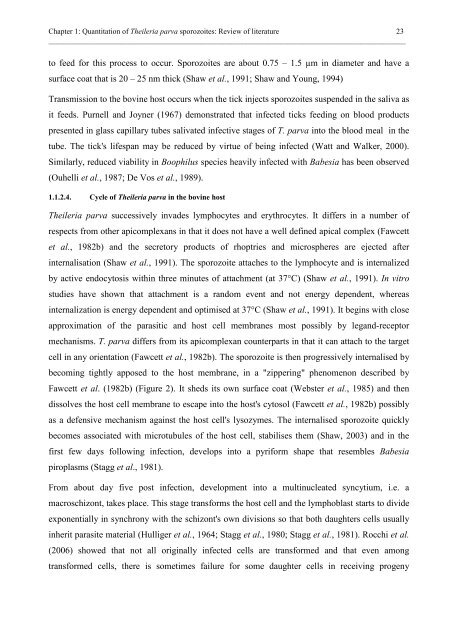In vitro quantitation of Theileria parva sporozoites for use - TropMed ...
In vitro quantitation of Theileria parva sporozoites for use - TropMed ...
In vitro quantitation of Theileria parva sporozoites for use - TropMed ...
Create successful ePaper yourself
Turn your PDF publications into a flip-book with our unique Google optimized e-Paper software.
Chapter 1: Quantitation <strong>of</strong> <strong>Theileria</strong> <strong>parva</strong> <strong>sporozoites</strong>: Review <strong>of</strong> literature 23<br />
______________________________________________________________________________________________<br />
to feed <strong>for</strong> this process to occur. Sporozoites are about 0.75 – 1.5 µm in diameter and have a<br />
surface coat that is 20 – 25 nm thick (Shaw et al., 1991; Shaw and Young, 1994)<br />
Transmission to the bovine host occurs when the tick injects <strong>sporozoites</strong> suspended in the saliva as<br />
it feeds. Purnell and Joyner (1967) demonstrated that infected ticks feeding on blood products<br />
presented in glass capillary tubes salivated infective stages <strong>of</strong> T. <strong>parva</strong> into the blood meal in the<br />
tube. The tick's lifespan may be reduced by virtue <strong>of</strong> being infected (Watt and Walker, 2000).<br />
Similarly, reduced viability in Boophilus species heavily infected with Babesia has been observed<br />
(Ouhelli et al., 1987; De Vos et al., 1989).<br />
1.1.2.4. Cycle <strong>of</strong> <strong>Theileria</strong> <strong>parva</strong> in the bovine host<br />
<strong>Theileria</strong> <strong>parva</strong> successively invades lymphocytes and erythrocytes. It differs in a number <strong>of</strong><br />
respects from other apicomplexans in that it does not have a well defined apical complex (Fawcett<br />
et al., 1982b) and the secretory products <strong>of</strong> rhoptries and microspheres are ejected after<br />
internalisation (Shaw et al., 1991). The sporozoite attaches to the lymphocyte and is internalized<br />
by active endocytosis within three minutes <strong>of</strong> attachment (at 37°C) (Shaw et al., 1991). <strong>In</strong> <strong>vitro</strong><br />
studies have shown that attachment is a random event and not energy dependent, whereas<br />
internalization is energy dependent and optimised at 37°C (Shaw et al., 1991). It begins with close<br />
approximation <strong>of</strong> the parasitic and host cell membranes most possibly by legand-receptor<br />
mechanisms. T. <strong>parva</strong> differs from its apicomplexan counterparts in that it can attach to the target<br />
cell in any orientation (Fawcett et al., 1982b). The sporozoite is then progressively internalised by<br />
becoming tightly apposed to the host membrane, in a "zippering" phenomenon described by<br />
Fawcett et al. (1982b) (Figure 2). It sheds its own surface coat (Webster et al., 1985) and then<br />
dissolves the host cell membrane to escape into the host's cytosol (Fawcett et al., 1982b) possibly<br />
as a defensive mechanism against the host cell's lysozymes. The internalised sporozoite quickly<br />
becomes associated with microtubules <strong>of</strong> the host cell, stabilises them (Shaw, 2003) and in the<br />
first few days following infection, develops into a pyri<strong>for</strong>m shape that resembles Babesia<br />
piroplasms (Stagg et al., 1981).<br />
From about day five post infection, development into a multinucleated syncytium, i.e. a<br />
macroschizont, takes place. This stage trans<strong>for</strong>ms the host cell and the lymphoblast starts to divide<br />
exponentially in synchrony with the schizont's own divisions so that both daughters cells usually<br />
inherit parasite material (Hulliger et al., 1964; Stagg et al., 1980; Stagg et al., 1981). Rocchi et al.<br />
(2006) showed that not all originally infected cells are trans<strong>for</strong>med and that even among<br />
trans<strong>for</strong>med cells, there is sometimes failure <strong>for</strong> some daughter cells in receiving progeny











